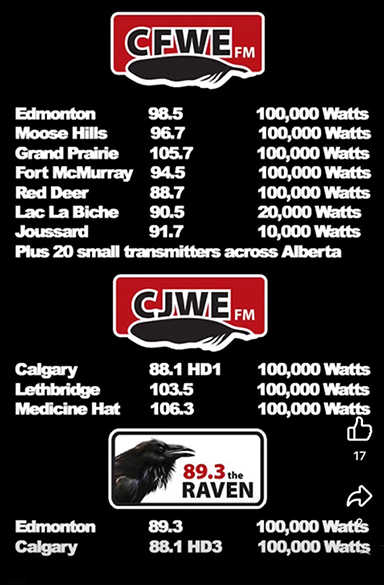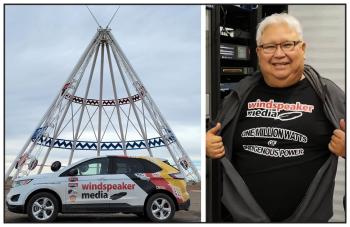Image Caption
With files from Keith Driver, CJWE Radio
Windspeaker.com
Audio
Medicine Hat listeners can now tune into CJWE Radio on 106.3 FM to be immersed in Indigenous traditions, stories, culture and really great music!
On Feb. 29, Bert Crowfoot, founder of the Aboriginal Multi-Media Society of Alberta (AMMSA), flipped the switch for its tenth 100,000-watt transmitter, linking Medicine Hat to the province-wide Windpeaker Media Radio Network.
“We launched the one in Medicine Hat and, I mean, that was a very moving and emotional and a powerful moment for me,” said Crowfoot. “Because when I flipped the switch, you can actually hear that transmitter fire-up and, you know, you can just feel the power.”
Sporting a t-shirt with the words “One Million Watts of Indigenous Power” for a photo commemorating the day, Crowfoot pulled a Superman pose breathing life into the saying “With the strength of Superman, anything is possible.”
“Nowhere in the history of radio in North America has anybody ever reached this milestone. I mean, even 500,000 watts,” said Crowfoot in an interview with CJWE’s Keith Driver. “This is a very proud moment for me. A very proud moment for radio and our staff.”
Crowfoot launched AMMSA, a not-for-profit communications society, more than 40 years ago. He has continued to develop it into a national media organization.
Through radio, print and the evolution into digital media, AMMSA has been committed to reflecting Indigenous culture to a growing and diverse audience with each branch of the media group.
CFWE radio launched in 1987 serving northern Alberta.
“I’m very goal-driven,” he told Driver. “And when we first started out, we said we wanted a 100,000-watt transmitter. We only had about 48 small 10-watters.” And AMMSA got that first one in the Moose Hills, dedicating it to the society’s long-time Elder and board member Joe P. Cardinal.
It was amazing to achieve that first one, Crowfoot said. It was the same that all the “big guys” had, the mainstream broadcasters.
When AMMSA set up the fifth tower, Crowfoot set a new goal.
“I wanted to be able to have one million watts.”
So AMMSA expanded the Radio Network to cover much of the province with:
- CFWE-FM
- CJWE 88.1 FM
- THE RAVEN 89.3 FM
- CUZIN Radio (digital)
and
- Red Beats Hip-Hop Indigenous Station (digital)
“I’ve always been an entrepreneur in spirit,” said Crowfoot.

One of the most tuned into shows is Radio Bingo, where people can participate in a game of bingo from their homes on Monday, Thursday and Saturday evenings.
Each night the payouts total about $14,000. During the winter months there are also two special nights where the bonanza climbs to $25,000.
“The same game is broadcast right across the province,” said Crowfoot, adding payouts are regulated by the Alberta Gaming and Liquor Commission (AGLC).
“We had a win in southern Alberta about three weeks ago, and we had a winner in northern Alberta.”
It’s thanks to the proceeds of Radio Bingo that AMMSA has been able to put up 100,000-watt transmitters. Gaming narrowly limits what bingo proceeds can be used for and expansion of radio infrastructure is allowed.
“Government funding didn’t build this network,” said Crowfoot. He’s heard the stereotypes that Indigenous organizations only grow through government handouts.
“We did this ourselves. We did this with the help of people supporting us through bingo, through advertising. Yes, we are a not-for-profit organization, but we run (AMMSA) like a business,” said Crowfoot.
His wise council about how government grants can’t be relied upon long-term runs through the organization. It comes from experience.
In 1990, AMMSA lost government funding for Windspeaker when the feds suddenly suspended Indigenous news grants. Only two of the 11 Indigenous print news publications across the country survived.
Windspeaker was one of them, because Crowfoot and the AMMSA board of directors had a goal of being self-sufficient within five years and had built up a nest egg from advertising revenues. That nest egg was used to grow and evolve Windspeaker, which has gone from hard copy to digital over the years.
“And it’s still here.” Windspeaker celebrated 40 years of publishing in March 2023.
AMMSA is committed to sharing Indigenous culture, tradition and language preservation. Five Indigenous languages are incorporated into the daily radio broadcasts.
“One of them has three distinct dialects, so that’s a total of seven different dialects that we broadcast,” he said—Cree, Blackfoot, Nakota Sioux, Dene and Michif.
“What we’ve done with our Indigenous programming is we’ve made it bilingual so that it’s in both (Indigenous) language and English.”
Language and communication are among the most important elements of reconciliation, said Crowfoot. And radio audiences, Indigenous and non-Indigenous, are truly appreciative of what the stations are offering.
Crowfoot shared a story of how a non-Indigenous mother and her daughter were listening to an interview with an Elder and they were so fascinated with the story that the two sat in the car outside of a store for 15 minutes until the interview was over.
Another person was raised next to a First Nations community and spoke honestly with Crowfoot about how he didn’t like it. This was until he started listening to the radio station and learned some of the language teachings, such as how to say hello. Once this man learned a few words and could communicate with his neighbours, he was able to get to know them and become great friends in the end.
“So, you want to talk about the power of language and reconciliation,” Crowfoot said. “You know, it doesn’t just slow down barriers, it breaks down these barriers. And so that’s why I think us broadcasting in one million watts all over Alberta is a powerful tool in reconciliation and understanding, for Indigenous people and non-Indigenous people understanding each other.”
Crowfoot continues to seek out the next opportunity for expansion of the radio frequencies in Alberta, researching where the next transmitter location should be placed.
“The next area we want to go in is to have a transmitter in High Level and maybe Peace River to kind of fill in the big gaps,” he said.
Achieving that goal of one million watts has Crowfoot reflecting on all the people who contributed to AMMSA’s success over the years.
“We have to remember where we came from.”
But, for today, “I feel satisfied. I’m happy. Now, two million watts,” Crowfoot said with a laugh.

